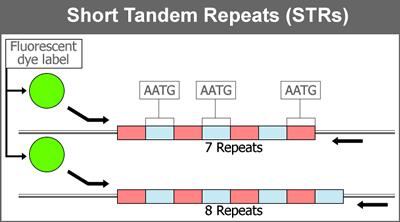Archival Notice
This is an archive page that is no longer being updated. It may contain outdated information and links may no longer function as originally intended.
Home | Glossary | Resources | Help | Contact Us | Course Map
There have been several technological developments since DNA testing was introduced into forensic science laboratories in the United States during the late 1980s. The historical developments are described in Crime Scene and DNA Basics for Forensic Analysts. The current technology is short tandem repeat (STR) analysis using the polymerase chain reaction (PCR).
The Human Genome Project has shown that there are tens of thousands of STR loci in human DNA. The selection of specific loci from the many available for use in forensic science laboratories is important for many reasons, but primarily to ensure that:
- The loci have a high discriminating power.
- The loci are stable in evidence samples.
- There is a consensus panel of core loci for use in DNA databases.
Author: Russell Vossbrink
Russell Vossbrink is the technical supervisor of the Regional FBI mtDNA lab at the Arizona Department of Public Safety. Russell is a member of the American Academy of Forensic Sciences (AAFS) and he has been a regular member and invited guest of the Scientific Working Group for DNA Analysis Methods (SWGDAM). Russell has presented at Promega, Combined DNA Index System (CODIS), AAFS, California Association of Criminalists (CAC), Southwestern Association of Forensic Scientists (SWAFS), California Association of Crime Laboratory Directors (CACLD) and the Bode Technology Workshop.
Additional Online Courses
- What Every First Responding Officer Should Know About DNA Evidence
- Collecting DNA Evidence at Property Crime Scenes
- DNA – A Prosecutor’s Practice Notebook
- Crime Scene and DNA Basics
- Laboratory Safety Programs
- DNA Amplification
- Population Genetics and Statistics
- Non-STR DNA Markers: SNPs, Y-STRs, LCN and mtDNA
- Firearms Examiner Training
- Forensic DNA Education for Law Enforcement Decisionmakers
- What Every Investigator and Evidence Technician Should Know About DNA Evidence
- Principles of Forensic DNA for Officers of the Court
- Law 101: Legal Guide for the Forensic Expert
- Laboratory Orientation and Testing of Body Fluids and Tissues
- DNA Extraction and Quantitation
- STR Data Analysis and Interpretation
- Communication Skills, Report Writing, and Courtroom Testimony
- Español for Law Enforcement
- Amplified DNA Product Separation for Forensic Analysts


